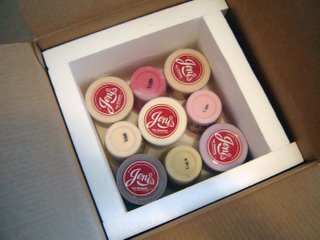Matenos, mingos, chowder, and grilled Matt Dillon
His table manners are basically what you would expect of a two year-old and we try to be amused rather than annoyed by his shenanigans. The other night at a restaurant he insisted on dipping his--well, E's-- French fries in ketchup and then in water. We tried to stop this at first but he clearly prefers his ketchup wet so we left it alone. After he was done eating the wet fries, he drank the ketchup water. "Is that good?" He nodded in the affirmative.
He has become an avid cook's helper. On Saturday he requested that we bake a cake for a birthday party (for whose birthday he didn't say). He went to the pantry and lurched up at the shelves chanting, "powder, powder," for baking powder. He likes to dump the ingredients I give him into the mixing bowl when I'm throwing together pancakes or corn bread and he insists on stirring. The second the batter hits the griddle he demands that I flip the pancakes and keeps demanding it until it's time. If he's in the kitchen when I'm cooking, he demands, "see it," and I lift him up so that he can take in what's on the stove. He likes to add pinches of salt to pasta water, after which I encourage him to lick his fingers and make a face.
One day last week after his nap, he went over to the pans hanging on the wall and said, "cooking." So I heated a pan up and had him help me wash and dry some mushrooms. While I sliced them, he moved them from a cutting board to a bowl. Then after he dumped them in the pan with some butter, he stirred and stirred until they were done. They cooled down for a minute, he put three slices in his mouth, chewed, waited a moment, and spit them out into my hands. He wanted to cook, not eat.
***
 This is a sort of Thai shrimp chowder that I made for lunch the other day and garnished with diced avocado and bacon bits. It's not too different from something I saw last week at Toast, which is a steady source of good ideas. Most basically, chowder is made with pork fat, fish or seafood, and dairy. I substituted coconut milk for regular milk or cream and added a finely minced Thai bird chile along with the onions and garlic. Coconut milk is an excellent substitute for dairy in many recipes. It has several virtues aside from its tropical flavor. It keeps a long time in the pantry and is easier than milk or cream on many people's digestion. I use it in rice pudding (with vanilla sugar, a big winner that I will write about one of these days) and it's on my long list of things to put in ice cream.
This is a sort of Thai shrimp chowder that I made for lunch the other day and garnished with diced avocado and bacon bits. It's not too different from something I saw last week at Toast, which is a steady source of good ideas. Most basically, chowder is made with pork fat, fish or seafood, and dairy. I substituted coconut milk for regular milk or cream and added a finely minced Thai bird chile along with the onions and garlic. Coconut milk is an excellent substitute for dairy in many recipes. It has several virtues aside from its tropical flavor. It keeps a long time in the pantry and is easier than milk or cream on many people's digestion. I use it in rice pudding (with vanilla sugar, a big winner that I will write about one of these days) and it's on my long list of things to put in ice cream.To make this soup I made a shrimp stock out of shrimp shells and threw in a leftover boiled potato and some frozen corn. Some chowder recipes call for flour to thicken but if you add cooked potatoes or let your raw potatoes cook a long time, the starch will thicken the chowder a bit.
Ingredients:
two strips of bacon, cut into small strips
one onion, chopped
two cloves of garlic, minced
one green Thai bird chile, seeded and minced
shrimp stock made from about the shells of about a pound of shrimp and a few cups of water
one can coconut milk, Chaokoh brand is the one I like
a handful of frozen corn
one large Russet potato, boiled ahead of time
about three quarters of a pound of medium shrimp, brined in salt and sugar for about fifteen minutes
an avocado
salt and white pepper
Cook the bacon over medium heat until it has rendered its drippings and gotten crisp. Reserve the bits as garnish and leave the fat in the pan. Add the onions, garlic, and chile and stir over medium-low heat to soften. Add the potatoes, corn, and shrimp stock and bring to a boil. Then add the coconut milk, stir well to mix it all together, and add salt and white pepper to taste. Add the shrimp, bring to a boil, and then turn the heat off and cover the pan. After five or ten minutes, it should be ready. Garnish with diced avocado and bacon.
We ate this with saltines but oyster crackers would be good too. E thought that the avocados were the better garnish. I would prefer not to have to choose one or the other.
***
Spell with flickr:









***
Read blogs!
Slaves of Academe is bitchy, clever, and inside-scoopy. I can't stop reading it.
And Fesser has tips for how to prepare the Oscar nominees, beginning with the supporting actors. On cooking Matt Dillon: "He'll never be Timberlake-tender, but grilled and served Tucscan-style with plenty of garlic, he offers a hearty treat." Dee Lish. I am eager to see how the other noms will be served. Do you fancy Judi Dench in a cassoulet? Rachel Weisz tartare? Paul Haggis haggis? Keep your eyes on the Cod.





















